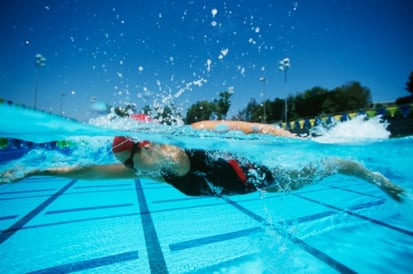 In my previous blog on swimming, I talked about the vast benefits that can come from adding lap swimming into your off-season workout regimen. But maybe you are already comfortable in the pool and swim on a regular basis; wouldn’t you like to get better and become more efficient in your stroke? By taking small steps to improve the different components that make up the specific strokes, you can become a better swimmer in a decently short amount of time.
In my previous blog on swimming, I talked about the vast benefits that can come from adding lap swimming into your off-season workout regimen. But maybe you are already comfortable in the pool and swim on a regular basis; wouldn’t you like to get better and become more efficient in your stroke? By taking small steps to improve the different components that make up the specific strokes, you can become a better swimmer in a decently short amount of time.
Focus on Form
As other sports, form tends to be one of the key players in overall success. Each stroke has a certain form that will allow the swimmer to be more efficient. Take some time to research the different strokes that you like to do and learn the correct form. Whatever swim stroke you happen to choose, the different pieces will consist of breathing, kicking, arm movement, location of chest and hips in the water, and what you do with your hands, feet, and ankles. I know it seems like a lot to think about, but you may really benefit by simply understanding what the stroke should look like.
Breathe More Efficiently
Breathing tends to be one of the hardest elements of a swimmer’s performance. Getting the breathing technique down right takes time, practice, and patience. Master breathing by using a kickboard or holding onto the side of the pool before combining it with the actual stroke and movement in the water. You also will need to learn your breathing cycle—for example, if I am swimming freestyle, do I need to take a breath every three or four strokes? You may need to learn to breathe on both sides and be able to turn your head to the left and right to get air.
Learn the Body Roll
This movement is used specifically in freestyle. Have you ever seen someone swimming freestyle (on their stomach) and when it’s time to take a breath, they pick their entire head up out of the water? The body roll will allow you to efficiently roll your upper body (and partially through the hips) to get air so that only part of your head is not in the water. This movement can be learned easily using different pool equipment like a pull buoy.
Slow Down
We all have the tendency, when getting into the pool to do some laps, to go a million miles an hour. Whether or not you mean to do it, you will quickly be made aware that you need to slow down because your breathing will remind you! Take your time, be patient, and learn the proper technique in every stroke by putting your foot on the break. You will be amazed, when you slow down the pace a little bit, at how long you can actually swim!
Develop an Efficient Kick
Another great way to improve your overall swimming skills is to learn the different kicks that go along with the various strokes. Each kick has specifics in how far to pull your heel back, how big of a splash you should be making, how far below the surface you want your hips and legs to be, etc. Utilize a kickboard or the wall, as you do in learning to breathe right, to master the different kicks.
Utilize Equipment
There are so many great tools out there to help you learn to swim better. Utilize things like kickboards to improve your breathing and kicking, pull buoys to work on your stroke, and fins to work through power kicks and master the body roll. At most pools you will usually see hand paddles to work on power in the pulling motion to propel you through the water faster, and maybe even gloves that have webbed fingers. All of these things will allow you to work on certain pieces of form one at a time.
Learn the Turns
When I was younger, I spent hours in the pool trying to learn how to do the flip turn. And while many think it’s simply “cool,” the flip turn happens to make your swim efficiency shoot through the roof. This move will also take some time to learn, but if you are patient and work on the timing of the flip turn, your lap swimming will soon be quicker.
Watch and Evaluate
Do not be afraid to have someone watch you and evaluate the different strokes you are working on. Often someone outside the water can easily tell if you are kicking too hard, slapping the water during your stroke, or not efficiently breathing. Take some time to have someone watch and give you tips to work on.
***
While this can seem like an overwhelmingly large list of things to work on, just choose one thing at a time. Each small tweak will make a huge impact on your overall swimming performance.
Remember Natatorium lap swimming is now free with your NIFS Membership! Learn More.
This blog was written by Amanda Bireline, Fitness Center Manager. To find out more about the NIFS bloggers, click here.

